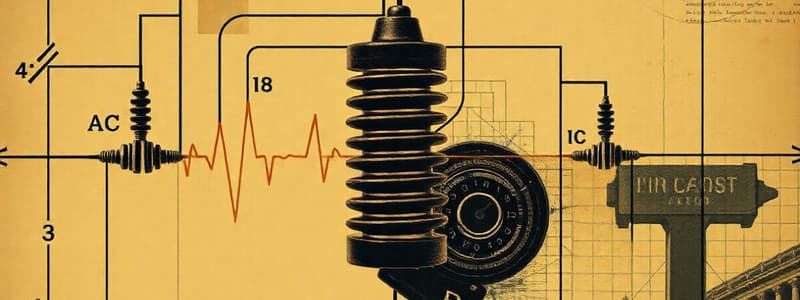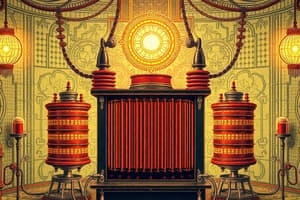Podcast
Questions and Answers
What trend occurs to atomic radius as you move across a period from left to right?
What trend occurs to atomic radius as you move across a period from left to right?
- Increases due to higher electron shielding.
- Increases then decreases after a certain element.
- Decreases due to increased nuclear charge. (correct)
- Remains constant regardless of the elements.
Match the following assertions with the correct options (A, B, C, D):
Match the following assertions with the correct options (A, B, C, D):
Power loss in ideal choke coil is zero. = Ideal choke coil has zero resistance. Average power loss in series LC circuit is always zero. = Average values of voltage and current in A.C. is zero. Average of sinusoidal A.C can never be zero for half cycle. = Impedance given by inductance does not depend on frequency. The divisions are equally marked on the scale of A.C. ammeter. = Heat produced is directly proportional to the current. The alternating current lags behind the e.m.f by a phase angle of $\pi/2$, when A.C. flows through an inductor. = The inductive reactance increases as the frequency of A.C. source decreases. Capacitor serves as a block for D.C and offers an easy path to A.C. = Capacitive reactance is inversely proportional to frequency. Choke coil is preferred over a resistor to adjust current in an A.C. circuit. = Power factor for inductance is zero, so power loss is also zero. The resistance of a coil for direct current is 5 ohm. An alternating current is sent through it. The resistance will remain same. = The resistance of a coil does not depend upon nature of current. When capacitive reactance is smaller than the inductive reactance in series LCR circuit, voltage leads the current. = In series LCR circuit inductive reactance is always greater than capacitive reactance. In series RL AC circuit voltage leads the current. = In series RC AC circuit current leads the voltage. An alternating current of frequency 50 Hz becomes zero, 100 times in one second. = Alternating current changes direction and becomes zero twice in a cycle. A sinusoidal alternating current does not show any average magnetic effects. = The average value of an alternating current is zero. The DC and AC both can be measured by a hot wire instrument. = The hot wire instrument is based on the principle of heating effect of current.
Which type of bond involves the transfer of electrons between metals and nonmetals?
Which type of bond involves the transfer of electrons between metals and nonmetals?
- Ionic Bonding (correct)
- Covalent Bonding
- Hydrogen Bonding
- Metallic Bonding
How does electronegativity change as you move down a group in the periodic table?
How does electronegativity change as you move down a group in the periodic table?
Which of the following best describes polar covalent bonds?
Which of the following best describes polar covalent bonds?
What is the term for the maximum possible amount of product from a chemical reaction?
What is the term for the maximum possible amount of product from a chemical reaction?
When balancing chemical equations, what must be true about the number of atoms?
When balancing chemical equations, what must be true about the number of atoms?
What effect does increased nuclear charge have on ionization energy across a period?
What effect does increased nuclear charge have on ionization energy across a period?
Which of the following quantum numbers indicates the energy level of an electron?
Which of the following quantum numbers indicates the energy level of an electron?
Which type of intermolecular force occurs when hydrogen is bonded to highly electronegative atoms such as N, O, or F?
Which type of intermolecular force occurs when hydrogen is bonded to highly electronegative atoms such as N, O, or F?
What is the molar mass used for in stoichiometry?
What is the molar mass used for in stoichiometry?
Flashcards
Ideal Choke Coil Resistance
Ideal Choke Coil Resistance
An ideal choke coil has no electrical resistance, resulting in zero power loss.
LC Circuit Power Loss
LC Circuit Power Loss
An ideal LC circuit, with no resistance, has no power loss in the ideal case.
Average Sinusoidal AC
Average Sinusoidal AC
The average value of a sinusoidal AC current over a complete cycle is zero.
Inductive Reactance and Frequency
Inductive Reactance and Frequency
Signup and view all the flashcards
AC Ammeter Divisions
AC Ammeter Divisions
Signup and view all the flashcards
Capacitor's DC/AC Behavior
Capacitor's DC/AC Behavior
Signup and view all the flashcards
Mole Concept
Mole Concept
Signup and view all the flashcards
Ionic Bonding
Ionic Bonding
Signup and view all the flashcards
Atomic Radius Period Trend
Atomic Radius Period Trend
Signup and view all the flashcards
Ionization Energy Period Trend
Ionization Energy Period Trend
Signup and view all the flashcards
Electron Configuration Basics
Electron Configuration Basics
Signup and view all the flashcards
Study Notes
Assertion and Reasoning Questions
- Q1 - The Assertion is True as an ideal choke coil has no resistance and thus no power loss. The Reason is also True and directly explains the Assertion.
- Q1 Answer: (A)
- Q2 - The Assertion is True, an ideal LC circuit has no resistance and thus no power loss. The Reason is also True but it is not a direct explanation for the Assertion.
- Q2 Answer: (B)
- Q3 - The Assertion is False, the average of a sinusoidal AC over half a cycle is not zero. The Reason is also False, inductive reactance does depend on frequency.
- Q3 Answer: (D)
- Q4 - The Assertion is False, the divisions on an AC ammeter are not equally marked. The Reason is True, heat produced is directly proportional to the current.
- Q4 Answer: (C)
- Q5 - The Assertion is True, the current lags behind the voltage in an inductive circuit. The Reason is False, inductive reactance increases as the frequency of the AC source increases.
- Q5 Answer: (C)
- Q6 - The Assertion is True, a capacitor blocks DC and allows AC. The Reason is also True and a correct explanation for the Assertion.
- Q6 Answer: (A)
- Q7 - The Assertion is True, a choke coil is better than a resistor to control AC current. The Reason is True but it is not a correct explanation for the Assertion.
- Q7 Answer: (B)
- Q8 - The Assertion is False, the resistance of a coil changes for AC current. The Reason is also False, resistance of a coil depends on the type of current.
- Q8 Answer: (D)
- Q9 - The Assertion is True, the voltage leads the current when capacitance is greater than inductance. The Reason is False, inductive reactance can be smaller than capacitive reactance.
- Q9 Answer: (C)
- Q10 - The Assertion is True, voltage leads the current in an RL circuit. The Reason is also True, current leads the voltage in an RC circuit. However, these are separate, and the Reason does not explain the Assertion.
- Q10 Answer: (B)
- Q11 - The Assertion is True, a 50Hz AC signal becomes zero 100 times a second. The Reason is also True and correctly explains the Assertion.
- Q11 Answer: (A)
- Q12 - The Assertion is True, an AC current does not have an average magnetic effect. The Reason is also True and correctly explains the Assertion.
- Q12 Answer: (A)
- Q13 - The Assertion is True, both DC and AC can be measured by a hot wire instrument. The Reason is also True and correctly explains the Assertion.
- Q13 Answer: (A)
Periodic Table Trends
- Atomic Radius decreases across a period due to the increasing positive charge of the nucleus pulling electrons closer.
- Atomic Radius increases down a group due to the addition of electron shells, pushing outer electrons further from the nucleus.
- Ionization Energy, the energy required to remove an electron, increases across a period as the atomic radius decreases, making it more difficult to remove an electron.
- Ionization Energy decreases down a group as outer electrons are further from the nucleus and experience a shielding effect from inner electrons.
- Electronegativity, the ability of an atom to attract electrons in a bond, increases across a period due to the increasing nuclear charge.
- Electronegativity decreases down a group as the outer electrons are further from the nucleus.
- Metallic Character, the tendency of an element to lose electrons, decreases across a period as elements become more nonmetallic.
- Metallic Character increases down a group as metals become more reactive and easier to lose electrons.
### Chemical Bonding
- Ionic Bonding occurs between metals and nonmetals and involves the transfer of electrons to form oppositely charged ions (cations and anions) which then attract each other.
- Covalent Bonding occurs between nonmetals and involves the sharing of electron pairs.
- Covalent bonds can be single, double, or triple depending on the number of shared electron pairs.
- Polar Covalent Bonds form when electrons are shared unequally due to differences in electronegativity between atoms.
- Nonpolar Covalent Bonds form when electrons are shared equally between atoms.
- Hydrogen Bonding is a special type of dipole-dipole interaction that occurs when hydrogen is bonded to very electronegative atoms such as nitrogen (N), oxygen (O), and fluorine (F).
Atomic Structure
- Protons, positive charge, located in the nucleus.
- Neutrons, neutral charge, located in the nucleus.
- Electrons, negative charge, orbit the nucleus in electron shells.
- Nuclear Charge is the total positive charge of the nucleus and is determined by the number of protons.
- Electron Configuration describes the distribution of electrons in an atom's orbitals.
- Electron configuration follows the Aufbau principle, Pauli exclusion principle, and Hund's rule.
- Quantum Numbers are a set of four numbers that describe the properties of an electron in an atom.
- Principal Quantum Number (n) describes the energy level of an electron.
- Azimuthal Quantum Number (l) describes the shape of an electron's orbital.
- Magnetic Quantum Number (m_l) describes the orientation of an orbital in space.
- Spin Quantum Number (m_s) describes the intrinsic angular momentum of an electron, called spin.
Stoichiometry
- Mole Concept defines a mole as containing 6.022 x 10²³ particles (Avogadro's number).
- The mole concept relates mass (g) to the number of moles using molar mass.
- Balancing Chemical Equations ensures an equal number of atoms for each element on both sides of the equation.
- Molar Ratios are derived from balanced chemical equations and are used to calculate amounts of reactants and products.
- Theoretical Yield is the maximum possible amount of product that can be obtained from a given amount of reactants.
- Actual Yield is the amount of product obtained from a reaction in the laboratory.
- Percent Yield is calculated by dividing the actual yield by the theoretical yield and multiplying by 100.
Studying That Suits You
Use AI to generate personalized quizzes and flashcards to suit your learning preferences.




